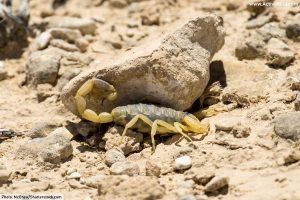
But before you dive in headfirst, let’s take a real look at what this involves. From setting up the right habitat to understanding its diet and care, keeping a Deathstalker scorpion can be rewarding if you know what you’re doing. To make this journey easier, I’ve put together everything a beginner needs to know, so grab your favorite drink, and let’s chat about how to create a perfect little world for your new eight-legged friend.
Understanding the Deathstalker Scorpion
The Deathstalker scorpion, scientifically known as *Leiurus quinquestriatus*, is one of the most venomous scorpions in the world. But before you jump to conclusions about its dangerous reputation, let me clarify that it rarely attacks humans unless provoked. Its bright yellow color and long, slender tail give it a unique look that many find appealing.
You might be wondering where these fascinating creatures come from. Deathstalkers are native to the deserts of North Africa and the Middle East. They thrive in arid environments, using their natural camouflage to blend in with the sandy surroundings. Understanding their origins helps you create a habitat that mimics their natural habitat effectively.
Creating the Perfect Habitat
Setting up the right habitat for your Deathstalker scorpion is crucial for its health and happiness. Start with a terrarium that’s spacious enough—at least 10 gallons for a single scorpion. These critters love to climb, so include features like rocks, logs, or even a small branch. This allows them to explore and feel secure.
Temperature and humidity are also key. Deathstalkers prefer a temperature range of 75 to 85 degrees Fahrenheit during the day. You can achieve this by using a heating pad or a heat lamp. For humidity, keeping it around 20-30% mimics their desert home. A small water dish will also help, but don’t overdo it; too much moisture can lead to mold and stress your scorpion.
Substrates and Decorations
Choosing the right substrate is equally important. A mixture of sand and coconut fiber can serve as a great base. It allows for burrowing, which is a natural behavior for scorpions. You might also consider adding some decorative items like fake plants or decorations to make the environment visually appealing while still providing hiding spots.
Always remember, a stressed scorpion can lead to health issues. Creating a comfortable, stimulating environment is essential for its well-being.
Feeding Your Deathstalker Scorpion
Now that you have a cozy habitat set up, let’s talk about what to feed your scorpion. In the wild, Deathstalkers feast on insects, so you’ll need to replicate that diet. Crickets, mealworms, and roaches are excellent options. Honestly, it’s pretty easy to feed them, but keep in mind that these little guys don’t eat every day.
Typically, feeding them every 2-3 days is sufficient. Just make sure to offer prey that’s not larger than the width of your scorpion’s pincers. An oversized meal can lead to stress or health problems.
Supplementing Their Diet
You might be wondering about supplements. While live food is essential, providing a calcium supplement can further boost their health. Dust the insects with calcium powder before feeding them to ensure your scorpion gets the necessary nutrients.
Keep an eye on how much they eat; if they seem uninterested for a length of time, it might be a sign of stress or an unsuitable environment.
Caring for Your Deathstalker Scorpion
Proper care goes beyond just feeding and habitat setup. You’ll need to handle your scorpion with care, especially since they can deliver quite a sting if they feel threatened. Here’s the thing: handling isn’t necessary regularly—scorpions can be stressed by too much interaction.
If you do decide to handle it, use a soft tool, like a paintbrush, to gently coax it into a container. Avoid grabbing or pinching, as this can harm your scorpion and might lead to a defensive sting.
Monitoring Health
You should consistently check for any signs of illness or stress. Common indicators include a refusal to eat, lethargy, or a change in color. If you notice any of these signs, it’s essential to reevaluate their environment or consult a vet specialized in exotic pets.
Cleaning the terrarium regularly is crucial as well. Remove uneaten food and waste to maintain a healthy living space. Taking these small steps can make a big difference in your scorpion’s overall health.
Common Myths About Deathstalkers
Before deciding to bring a Deathstalker into your home, it’s good to clear up some common misconceptions. Many people think that all scorpions are aggressive and dangerous. While Deathstalkers have potent venom, they’re generally not aggressive unless provoked.
Another myth is that they require a lot of interactive care. In reality, scorpions are relatively low-maintenance pets. They don’t need daily handling, making them suitable for those with busy lifestyles.
Legal Considerations
Lastly, you might be wondering about legalities. In some places, owning a Deathstalker scorpion may require permits. Make sure to do your research before purchasing one. Check local regulations to ensure you’re in the clear.
Wrapping It Up
Keeping a Deathstalker scorpion as a pet can be an exciting adventure for those willing to do their homework. By understanding their habitat, diet, and care needs, you can create a thriving environment for your new scaly friend. Just remember to respect their space and needs—being a responsible pet owner is crucial.
So, if you’re ready to take on the challenge, you may just find that this exotic pet can be a fascinating companion! Keep learning, and enjoy your journey with your Deathstalker!
